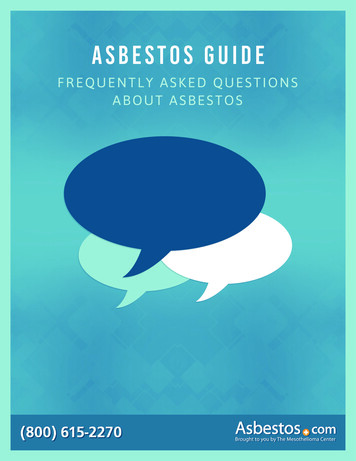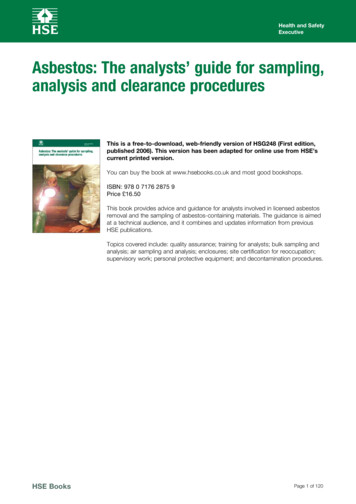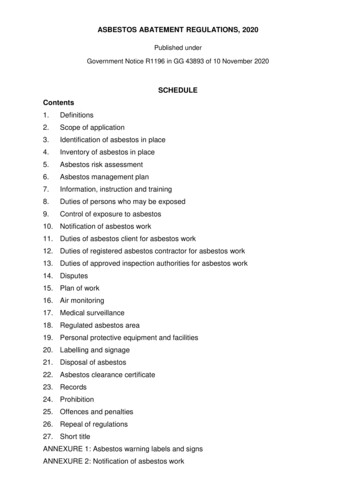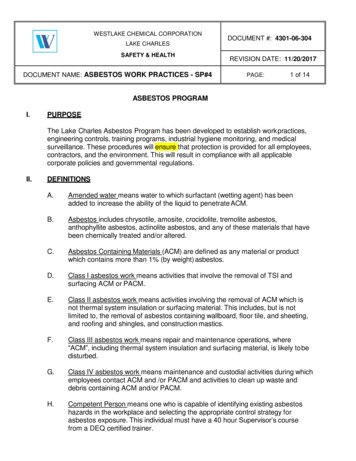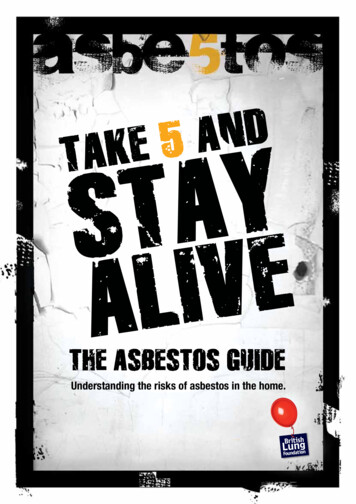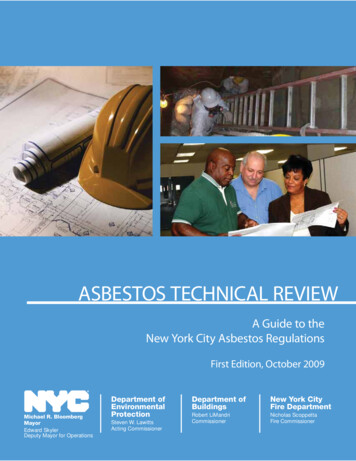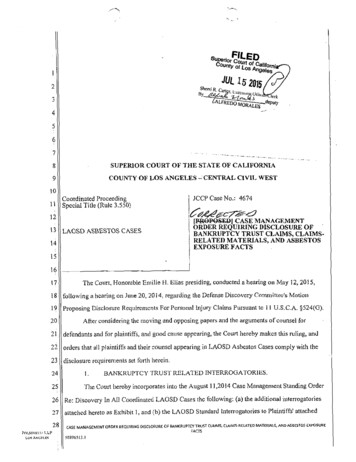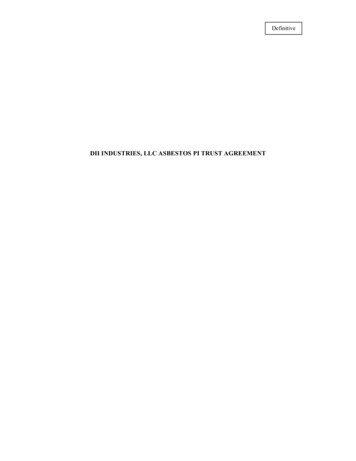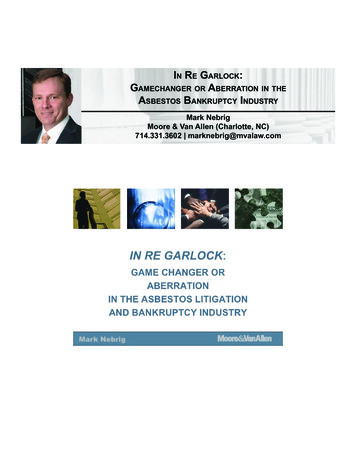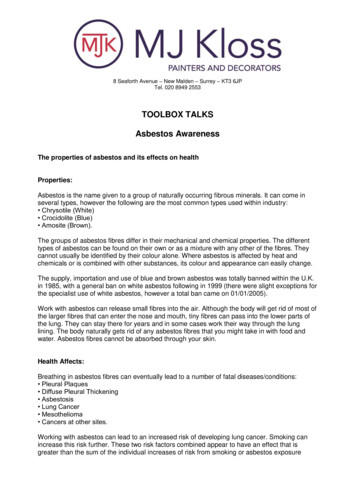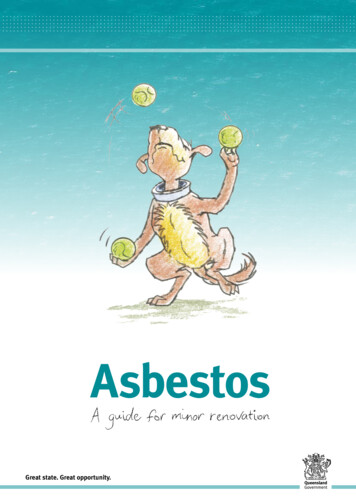
Transcription
AsbestosGreat state. Great opportunity.
AsbestosSection 1Section 2Section 3Section 4Section 5Section 6Asbestos: play it safeWhat is asbestos? Is it dangerous? Where is it found?Types of asbestos-containing materialsWhat is non-friable and friable asbestos? Common locations in Queensland homes andcommercial buildings Asbestos in vinyl sheet flooring Testing materials for asbestosWorking safely with non-friable asbestosChecklist before starting a job Information for tradespeopleClearance inspections Managing your renovation jobSafe work proceduresDrilling Painting or sealing Removing ceramic tilesRemoving non-friable asbestos sheetsTransport and disposalHomeowners Contractors and businesses Regulated waste transportHelpful publications and contacts3Asbestos: a guide for minor renovationFor more information visit the Queensland Government website or phone 13QGOVwww.qld.gov.au/asbestos13 74 68
Asbestos: play it safeThis guide mainly applies to tradespeople and‘do-it-yourself’ (DIY) home renovators carryingout minor renovations on building materialsthat may contain asbestos.This guide doesn’t cover the major removal work of eithernon-friable or friable asbestos.Minor renovations are small scale and usually completedquickly. Examples include:maintenance or surface preparationof walls, roofing, ceilings or flooringScientific and medical evidence supports the fact thatsimply living or working in a building containing asbestos isnot dangerous as long as the asbestos product is in goodcondition (i.e. undamaged and undisturbed), meaning theasbestos fibres are still tightly bound within the compound(usually cement).installation of plumbing componentsIn this case the safest option is to leave them alone –let sleeping dogs lie!installation of electrical componentsor data cablesIs asbestos dangerous?Visually inspect the materials from time to time fordeterioration and damage.tiling and floor covering tasksremoving asbestos cement sheets lessthan 10 m2 in total area.Asbestos is a naturally occurring mineral foundin the ground. It contains strong fibres thathave excellent durability, fire resistance andinsulating properties.Asbestos fibres are 50–200 times thinner thana human hair, can float in the air for a longtime, can be invisible to the naked eye and canbe breathed into the lungs.Asbestos was manufactured into manydifferent materials, commonly used in theAustralian building industr y between the1940s and late 1980s.All forms of asbestos have been nationallybanned from use since 31 December 2003.However, the ban does not mean that allasbestos installed prior to this date needsto be removed (e.g. asbestos-containingmaterials in houses).Chrysotile asbestos (white).4Crocidolite asbestos (blue)Asbestos: a guide for minor renovationFor more information visit the Queensland Government website or phone 13QGOV
Asbestos: play it safeWhat are the possible health effects ofasbestos exposure?Asbestos can affect your health if fibres are breathed intothe lungs. Most fibres are removed by your body’s naturaldefences, however, some fibres can remain in the lungs.The possible health effects of asbestos are: asbestosis (progressive and irreversible scarring of lungtissue that impairs breathing) lung cancer mesothelioma, a cancer of the linings around the lungsand abdomen non-cancerous diseases that affect the linings aroundthe lungs and abdomen (commonly called ‘benignpleural diseases’).Some diseases can take up to 50 years to develop, butothers can also develop in much less time than that. Whilethere are some treatments for asbestos related diseases,there are no known cures.Where is asbestos commonly foundin buildings?It can be difficult to tell whether a building has asbestoscontaining materials, just by looking at it.As a general rule, if the building was built: before the mid 1980s, it is highly likely that it would havesome materials containing asbestos between the mid 1980s and 1990, it is likely that it wouldhave materials containing asbestos after 1990, it is highly unlikely it would have materialscontaining asbestos.If you are not sure whether a building material containsasbestos, play it safe and assume that it does. Alternatively,seek advice from an asbestos consultant or other competentperson experienced at working with asbestos or get thematerial tested by a laboratory.Play it safe with asbestos. If you arenot sure whether a material containsasbestos, assume that it does and takeadequate precautions.If asbestos is in good condition,leave it aloneWhen asbestos is disturbed, broken, sanded orcut, asbestos fibres are released into the air andcan increase the risk of being inhaled by yourself,family or neighbours.While most cases of asbestos related diseasesresult from sustained workplace exposure toasbestos fibres, some asbestos related diseases,such as mesothelioma, can result from briefperiods of breathing in high concentrationasbestos fibres without adequate protection.To minimise anyone being exposed to asbestosfibres, it is important that DIY home renovatorsand tradespeople prevent the release of asbestosfibres into the air as much as possible and takenecessary precautions to capture them before theybecome airborne during any disturbance.Do new building materials containasbestos?New building materials do not contain asbestos. Since31 December 2003, asbestos and all products containingasbestos have been banned throughout Australia. It isillegal to import, store, supply, sell, install, use or re-usethese materials.Asbestos has not been used in building materials sincethe late 1980s. Cellulose fibres are now used insteadof asbestos in building materials. Non-asbestos fibres,such as glass, are now used in insulation products.5www.qld.gov.au/asbestos13 74 68
Types of asbestos-containing materialsWhat is non-friable and friableasbestos?Non-friable asbestos-containing materials werecommonly used, in both domestic and nondomestic buildings for:There are two main types of material used in buildingconstruction that contain asbestos: non-friable (bonded)and friable (loosely bound) asbestos. roof sheeting and capping gutteringNon-friable (bonded) asbestos gables, eaves/soffitsNon-friable asbestos-containing materials are commonlyfound in both domestic and non-domestic buildings. They arenot dangerous if they are in good condition (i.e. undamaged)and remain undisturbed. Non-friable asbestos cement bondedproducts are solid, rigid and the asbestos fibres are tightlybound in the material to prevent them becoming airborne.This kind of material is commonly known as ‘fibro’,‘asbestos cement’ or ‘AC sheeting’ and typically contains5–20 per cent asbestos. water pipes and fluesAsbestos can also be found in asbestos vinyl tiles that wereoften used in Queensland houses. Asbestos vinyl tiles contain8–30 per cent asbestos in a tightly bonded matrix. They donot have a backing to the tile and are usually glued directlyto the floor. It should be noted that glue used to adhere theasbestos vinyl tiles to the floor might also contain asbestos.Where any bonded asbestos product has deteriorated to sucha state that it can turn to dust with very light pressure, such ascrushing with your hand, it should be treated as being friable. car ports and shedsMoulded telecommunicationspitZelemite backing board to an exte6rnal switchboard DT surrounds (disconnector trap surrounds) wall sheeting (flat or a weatherboard style) zelemite backing boards to the switchboards flexible building boards imitation brick cladding fencing waterproofing membrane telecommunications pits some window putty expansion joints packing under beams concrete formwork.Ex ter nal claddingV inyl floorcontaining asbestotilesAsbestos: a guide for minor renovationFor more information visit the Queensland Government website or phone 13QGOVsVent pipe cap and socket fitted overa vent pipe
Types of asbestos-containing materialsSlotted hardi fle xsoffit sheetingFlat sheet claddingHardi plankwall sheetingDT sur round (disconnector trap)Friable (loosely bound) asbestosLoosely bound friable asbestos-containing materials arepotentially very dangerous. Friable materials can contain upto 100 per cent asbestos. The fibres are quite loose and canbe turned to dust and released into the atmosphere withvery light pressure, such as crushing with your hand.Hardi plank w o v en fencingTextile wadding usedin the porcelain fuseholdersFriable asbestos was primarily used in commercial andindustrial settings for fire proofing, sound proofing andinsulation. Sometimes, small amounts of friable asbestoswere used in domestic buildings, including: in old domestic heaters, stoves, hot water systems andpipe lagging in the backing of sheet vinyl floor coverings inside fireplaces within fire doors in the main entry doors of units andstairwells sprayed on vermiculite insulation material in somecommon areas of unit blocks7www.qld.gov.au/asbestos13 74 68
Types of asbestos-containing materialsLow density boardLow density asbestos fibre board is a lightly compressedboard which looks similar to asbestos cement sheeting orplasterboard but is different to AC sheeting because it can beeasily bent in the hand or dented by soft pressure. It is softerthan AC sheeting because calcium silicate plaster was used tobond the material instead of cement.The asbestos content of lightly compressed board can rangeup to 70 per cent. It was manufactured as a flat sheet productalthough some perforated sheeting, typically usedfor acoustic ceiling applications, was also manufactured.Commonly known as low density asbestos fibre board, someproduct names include ‘Asbestolux’ and ‘Duralux’. If lowdensity board is in good condition and left undisturbed itpresents a low risk. However, because it is softer than ACsheeting, low density board can crumble more easilywhen disturbed.If low density board is to be removed, it will be necessaryto determine whether the material is friable or non-friableon a case by case basis. Such assessments may only beundertaken by persons who are competent in working withasbestos-containing materials. Where the assessmentindicates the low density board is in poor condition and/orcould become friable (e.g. breaking up) during the removalprocess, an A class removalist must be engaged to safelyremove the material.Due to the need for professional assessment of the friablenature of low density board as well as its high asbestoscontent with subsequently higher potential to releaseasbestos fibres, homeowners must not undertake anywork with this product. Homeowners should ensure anappropriately qualified tradesperson is engaged for any workwith low density asbestos fibre board. The Public HealthAct 2005 prohibits the removal of friable asbestos productsunless the person holds an A class licence.View common locations of asbestos-containing materials in two types ofQueensland houses and a commercial building on pages 24-26 of this guide.Queenslander: type 1Example of a house built in the 1970sQueenslander: type 2Concrete or clay (terracotta) tiled roofCommercial buildingsPage 24Page 25Page 268Asbestos: a guide for minor renovationFor more information visit the Queensland Government website or phone 13QGOV
Types of asbestos-containing materialsFriable asbestos in vinyl sheet flooringVinyl sheet flooring sometimes contained friable (looselybound) asbestos material in the backing of the product (theside attached to the floor) or as an underlay. The vinyl sheetitself does not contain asbestos.Manufacturers sometimes incorporated a felt-like ‘backing’ forcushioning and insulation purposes and it typically contains80–100 per cent asbestos. This product can be identified as itwas usually supplied in sheet form and has a ‘terrazzo’ type(colourful marble or stone chip) pattern look on the surface.It is most often found in buildings constructed before themid-1980s.Friable materials, such as the backing of this vinyl sheetflooring are potentially very dangerous because theasbestos fibres can become airborne very easily. Thesematerials must only be handled and removed by an asbestosremovalist with a class A asbestos removal licence.Laboratories that analyse building materials forasbestos can be foundby contacting the NationalAssociation of TestingAuthorities.The laboratories can also give you advice on how tocorrectly take and senda sample. There will befeesinvolved. You can alsocontact an asbestos consultantor competent person foradvice by searching theinternet or local phonedirector y.National Association ofTe1800 621 666ww w.nata.asn.austing AuthoritiesAsbestos backed vinyl sheet flooringAsbestos backed vinyl sheet flooringAsbestos backed vinyl sheet flooring9www.qld.gov.au/asbestos13 74 68
Working safely with non-friable asbestosThe chance of inhaling asbestos fibresincreases when renovating or carrying outrepair work on asbestos materials, but therisk to your health is very low if you take thenecessary safety precautions.Laws about asbestosIn Queensland, there are a number of laws relating to buildingand renovating. There are also specific laws designed toprotect the health of homeowners, their families, the generalcommunity and tradespeople by ensuring asbestos ishandled, removed and disposed of safely. Legal action can be taken against you for working*unsafely with asbestos. Government officers will investigate complaints and issuenotices, on-the-spot fines or prosecute if you are breakingthe law. You could also have legal action taken against you byother people, such as a neighbour.TradespeopleTradespeople are legally responsible for determining whetherthey are dealing with asbestos-containing materials beforestarting any work. They must have it identified by a competentperson, have a sample tested or simply assume asbestos ispresent. Any tradesperson disturbing asbestos should usesafe work procedures for the work they are contracted to carryout and these must comply with the Work Health and SafetyRegulation 2011.Seven steps you need to take beforeyou start work:1. Check with your local council to see if you need approvalsfor the planned workSome renovation activities may require approvals fromyour local council, such as planning permits and buildingapprovals. Please contact them before starting any work.2. Decide how you will dispose of the asbestos wasteYour choices are to dispose of the waste yourself, if it’s asmall quantity, otherwise you must use a licensed wastecontractor. If disposing of asbestos waste yourself, it isimportant to contact your local council to find out specificrequirements (e.g. where to take the waste and how muchit will cost). You will need to wet down the asbestos andpackage it in thick plastic to minimise the chance of anyasbestos fibres getting into the air.3. Determine whether you need a licensed asbestosremovalistAnyone planning to remove 10 m2, or less, of non-friablematerial containing asbestos, does not require an asbestosremoval licence or certificate. However, safety precautionsstill need to be taken to minimise asbestos fibres gettinginto the air.As a guide, 10 m2 is equivalent to about four sheets ofasbestos cement wall sheeting, or usually only one wall ofan average bathroom.Before starting a job with asbestos, consider your alternatives:Take samples from the proposed work area and have them tested to determine if asbestos is present.Consider working around any asbestos materialsConsider leaving asbestos materials in good condition undisturbed.Try painting or sealing an asbestos product rather than removing it.Contract a licensed asbestos removalist to safely remove asbestos rather than removing it yourself (however,if friable asbestos-containing materials need to be removed, you MUST use a Class A licensed removalist).*Working includes breaking, cleaning, cutting, maintaining, removing, repairing, storing and using. It also includes separating asbestos wastefrom other waste. Removing includes moving an asbestos-containing material from the position where it was installed.10Asbestos: a guide for minor renovationFor more information visit the Queensland Government website or phone 13QGOV
Working safely with non-friable asbestosFor work other than removal (for example preparing anon-friable asbestos wall for painting or drilling a hole forpiping or electrical cabling) you do not require a licence orcertificate. However safety precautions to minimise asbestosfibres getting into the air must be taken.If you are planning to remove friable asbestos-containingmaterials (loosely bound), you MUST use a business witha current class A asbestos removal licence to do the work.If you are a tradesperson or other business operatorremoving more than 10 m2 of non-friable asbestos materialsyou can only carry out this work under the authority ofa class B or class A asbestos removal licence, issued byWorkplace Health and Safety Queensland.Homeowners planning to remove more than 10 m2 of nonfriable asbestos-containing materials must either: use a business with a current class A or class B asbestosremoval licence to do the work; or hold a certificate obtained under arrangementsestablished by Queensland Health. Information on thesecertificates is available by calling 13QGOV (13 74 68) orgoing to www.qld.gov.au/asbestos.Homeowners or tradespeople seeking a business thatremoves asbestos materials should search the internet ortheir local phone directory. Check the business holds theappropriate asbestos removal licence (class A or B) issuedby Workplace Health and Safety Queensland.4. Think of those who could be affected by your workWhen planning your work, don’t forget to consider yourself,other people in the building, neighbours and family pets.Under public health laws and workplace health and safetylaws, you have a responsibility to make sure that you protectyour own and others’ health by not releasing asbestos fibresinto the air during your work or leaving behind asbestos dustonce you’ve completed the task.Here are some tips to consider your practices before youbegin work: Prevent public access to the work area. Avoid dropping or the unnecessary breaking of asbestoscontaining sheets to reduce the release of fibres into the air. Use disposable clothing such as disposable coveralls andboot covers to ensure fibres don’t get trapped in yourclothing and spread into the air later. Speak to people in neighbouring properties about thework you’re about to do. It is important to explain thesafety precautions you will be taking to minimise thechance of asbestos fibres getting into the air. Do not take work clothing home to be laundered that mayhave been exposed to asbestos work, as they may havebeen contaminated with asbestos fibres.Avoid prohibited activitiesThere are restrictions on high risk activities (andsubstantial penalties apply) when working with asbestoscontaining material, as these activities will releaseextensive amounts of asbestos fibres and will alsocontaminate the equipment:a) Never use power tools such as angle grinders, circularsaws and electric sanders on surfaces that containasbestos unless the equipment is designed and/orused in a manner that captures or suppresses airborneasbestos fibres, such as dust extraction devicesconnected to an H class and HEPA filtered industrialvacuum cleaner. Use only low speed items and handoperated drills when conducting home renovations.Asbestos residueremaining after waterblasting a roofWater blasting asbestos cement will cause debristo be sprayed everywhere. It puts you and yourneighbours’ health at risk and is very difficult tocontain the residue material. The result could cost youmore than 100 000 to clean up.b) Never use high pressure water blasters.c) Never use compressed air tools.d) Never use household vacuum cleaners.11www.qld.gov.au/asbestos13 74 68
Working safely with non-friable asbestos5. Plan your activity and purchase necessary equipmentPlan the job and how you will purchase the necessaryequipment in advance to work with asbestos. Safe workprocedures in this booklet and on the website detail theminimum equipment required, which is readily availablefrom hardware stores and safety equipment suppliers.During the job, temporarily store waste asbestos either ina plastic lined skip or on top of thick plastic ready for laterwrapping. Make sure you clean up debris and decontaminatethe work area before allowing access by others.6. Know how to protect yourself from exposureWearing the right personal protective equipment (PPE)is essential to protecting your health when working withasbestos. Personal protective equipment is available frommost hardware or safety equipment suppliers. After your work is complete, spray your disposablecoveralls with a light mist of water and remove them.Keep your respirator on when doing this. Do not keep or reuse the disposable clothing and donot shake the dust out of them. Quickly dispose of theclothing by sealing it in an asbestos waste bag.Shower afterwardsTo remove any dust and asbestos that may be on your skin,thoroughly shower and wash your hair after finishing the task.7. Plan to dispose of asbestos waste quickly and correctlyClean up, package and dispose of all asbestos waste(including PPE, scraps and surplus asbestos) as soon aspossible. Under Queensland law, no asbestos can be stored,given away, sold or kept for another use.Wear disposable clothingDisposable coveralls with a hood should be used to prevent thecontamination of any clothing, including your shoes/boots.Wear the proper respiratorOrdinary dust masks are not effective to preventinhaling asbestos fibres and dust. Cheap masksmay save money, but they do not provide adequateprotection against asbestos fibres.You will need to purchase and use a respirator designedspecifically for working with asbestos. Wear a halfface filter respirator fitted with a class P1 or P2 filtercartridge, or a class P1 or P2 disposable respiratorappropriate for asbestos.Respirators should comply with Australian StandardAS1716. This number should be printed somewhere onthe mask. Men should be clean-shaven to make sure of thebest seal between their face and the mask. The respirator should have an airtight fit. Read andfollow the manufacturer’s instructions on how tocheck the fit of the respirator. Respirators should be continuously worn until allwork and cleaning up is completed and contaminatedclothing has been removed, bagged and sealed.The last thing to be removed is the mask.Example of a respirator for usewhen working with asbestos.12Example of a disposable P2respirator with two straps,suitable for working withasbestos.Men should be clean-shavento ensure a good seal betweentheir face and the mask.Asbestos: a guide for minor renovationFor more information visit the Queensland Government website or phone 13QGOVThis type of dust mask with onestrap DOES NOT prevent theinhalation of asbestos fibres.
Working safely with non-friable asbestosClearance inspection for the minor workon asbestos-containing materialsWhen a contractor has completed the work, a visualinspection of the work area should be conducted prior toresumption of normal occupancy.This ensures that all asbestos waste has been removed andthe area has been properly cleaned with no visual evidenceof dust and debris. Particular attention should be paid to thepresence of dust on all horizontal surfaces, such as, windowsills, architraves, skirtings, the tops of air-conditioningducts, fan blades and flooring.Nothing precludes a homeowner or tradespersonfrom demanding a higher standard for safe asbestoswork procedures to those outlined in this guide.Homeowners can reasonably expect tradespeopleperforming minor renovation works on asbestoscontaining materials to follow the safe workmethods outlined in this guide.Written confirmation that the work area is clean and freeof asbestos waste, dust, and debris should be given to thehome owner.What if I accidentally break asbestos?What if I need to put a hole in non-friableasbestos-containing material?If it is necessary to put a hole in non-friable asbestoscontaining material (e.g. for a new window or powerpoint), it could be safer to remove the whole sheetfollowing safe work procedure 4 on page 19 of thisguide and replace it with non-asbestos sheeting(e.g. plywood, plasterboard, fibre cement sheeting)and cut the hole in the new sheeting.If you accidentally break an asbestos-containingmaterial, the safest way to manage any health risks isto wipe up any dust with a damp cloth or damp papertowel. Place the damp cloth or damp towel inside aplastic bag, tie the bag up and then place this insidea second plastic bag. Tie the final bag up tightly andplace into your rubbish bin.Do not use a normal vacuum cleaner as it cannot filterout all particles and can release more asbestos fibresinto the air.If the asbestos-containing material is cracked, youshould seal the crack with a product like PVA glue,polyfiller or paint. If the damage is more significant,the entire sheet should be replaced and the old sheetdisposed of correctly.13www.qld.gov.au/asbestos13 74 68
Safe work procedures2. Prepare the work areaDrilling into non-friable asbestoscontaining materialsTo reduce the risk of asbestos fibres being released intothe air, caution must be taken when drilling into non-friableasbestos-containing materials. Follow the safety proceduresbelow when drilling vertical and horizontal surfaces: Remove all loose and unnecessary items from thework area. Restrict other people from entering the asbestoswork areas (e.g. by closing a door or putting upwarning barriers). Use plastic sheeting secured with duct tape to coverany surface of the work area and act as drop sheets. Turn off air-conditioning and fans.1. Ensure you have the correct equipment needed Put on your personal protective equipment. Hand drill or low-speed battery powered drill. Check the fit of your respirator as per themanufacturer’s instructions. Disposable cleaning rags (e.g. paper towel or adisposable cloth). Bucket of water and/or a misting spray bottle.3. Drilling stepsStep 1:Tape the point to be drilled and the exit point (ifpossible).Step 2:Cover the drill entry and exit points (if accessible)on the asbestos sheet with a generous amount ofa thickened substance (e.g. shaving cream).Step 3:Drill a hole through the bottom of the disposable cup.Step 4:Fill or line the inside of the cup with the thickenedsubstance.Step 5:Put the drill bit through the hole in the cup andmake sure the drill bit extends beyond the lip ofthe cup.Step 6:Align the drill bit with the marked point.Step 7:Ensure cup is firmly held against the surfaceto be drilled.Step 8:Drill through the surface.Step 9:Remove the cup from the surface and dispose inasbestos waste bag. Duct tape. Sealant (e.g. PVA glue). A paste or gel like substance (e.g. wallpaper paste,shaving cream or hair gel). Several 200 micron (0.2 mm) thick plastic bags forasbestos waste. A roll of 200 micron (0.2 mm) thick disposable plasticdrop sheeting to cover the floor and other surfacessuch as furniture and window ledges under where youare drilling. A sturdy, disposable clear plastic cup. Personal protective equipment consisting of a P1 or P2respirator, disposable coveralls, safety goggles andshoe protectors.Warning!Never use a high-speed drill on an asbestoscontaining material because it will quickly releaseasbestos fibres into the air. Only use a hand drill or alow‑speed battery powered drill and follow this safework procedure closely.Step 10: If a cable is to be passed through the drilled hole,insert a sleeve to protect the inner edge of the holeor seal the edges with a sealant such as PVA glueor paint.Warning!Check for electrical hazards. As water is being usedin this task, it is safest to turn off all electricity whereyou are working to prevent electrocution.14Disposable cup with holethrough bottomAsbestos: a guide for minor renovationFor more information visit the Queensland Government website or phone 13QGOVResidue dust captured inshaving cream inside cup
Safe work procedures4. Clean upVacuumingImportant! Keep your respirator on until all clean up isfinished and you have removed your disposable clothing.The use of shadow vacuuming when using a powerdrill will also capture airborne dust and debris fromthe asbestos-containing material. Never use dusting, sweeping or brushing methods asthey will circulate asbestos fibres into the air. If available, use an H class industrial vacuum cleanerthat complies with AS/NZS 60335.2.69 fitted with aHEPA filter that complies with AS4260-1997 to clean yourequipment and any remaining visible dust in the workarea, including framework or cavities. Domestic vacuumcleaners should never be used. Even if they have a HEPAfilter, they are unsuitable for asbestos work.Shadow vacuuming requires the operation of anH class industrial asbestos vacuum cleaner thatcomplies with AS/NZS 60335.2.69 fitted with aHEPA filter and that complies with AS4260‑1997.The vacuum head should be either directlyattached to the drilling equipment or used as closeas possible to the tool. Wet wipe surfaces where asbestos fibres may havecollected. Do not resoak used rags in the bucket, as thiswill contaminate the water. Either fold the rag and use theclean surface or use a new rag.Domestic vacuum cleaners should never be used.Even if they have a HEPA filter, they are unsuitablefor asbestos work. While still wearing your protective equipment, lightlyspray the plastic with a diluted mixture of 1:5 PVA glueand water to hold remaining dust. Carefully roll or foldplastic drop sheeting from the floor or ground, and othersurfaces such as furniture and window sills, so anyremaining dust or debris does not spill.Painting or sealing non-friableasbestos-containing materialsWhile it’s not always necessary to seal, paint or cleannon-friable asbestos-containing materials that are in goodcondition, the edges of sheets should be se
'asbestos cement' or 'AC sheeting' and typically contains 5-20 per cent asbestos. Asbestos can also be found in asbestos vinyl tiles that were often used in Queensland houses. Asbestos vinyl tiles contain 8-30 per cent asbestos in a tightly bonded matrix. They do not have a backing to the tile and are usually glued directly to the .
